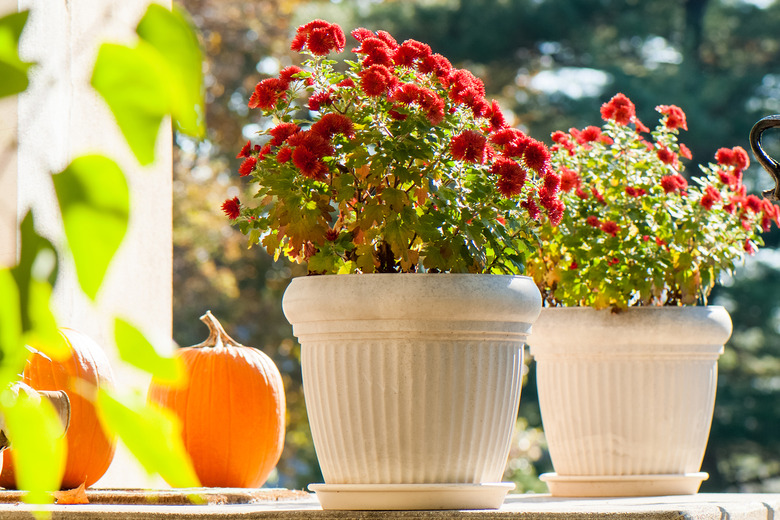How To Overwinter Mums In Pots
We may receive a commission on purchases made from links.
If you're yearning for another year of beautiful fall blooms, you can keep your potted mums alive in winter by protecting them from harsh winter weather. Many garden mums (Chrysanthemum spp.) are perennials in USDA plant hardiness zones 5a through 9a, and they're often grown in pots as annuals in other zones. Hardy garden mums can survive winter in pots. On the other hand, florist mums, also known as floral mums, are less cold hardy and may not survive the winter even with protection. These potted plants found at the florist shop or supermarket that are often given as gifts can be enjoyed while they bloom and are then tossed (or composted).
Overwintering potted mums in a sheltered place is the easiest way to keep them alive in cold climates. Even where mums are cold hardy, potted plants purchased in the fall don't have time to establish roots in the ground and could benefit from overwintering indoors. Here's how to keep hardy mums in the winter so you can once again have some gorgeous fall color on your front porch next year (and save some money).
How to Overwinter Mums in Pots
How to Overwinter Mums in Pots
Follow these steps to shelter your potted mums in a safe spot for winter so that you can enjoy more blooms in your fall garden next year:
1. Determine When to Bring Mums Indoors
Because their roots are above ground, potted mums are more susceptible to damage from freezing temperatures. Potted mums can take the occasional light frost but should be brought inside before the first frost hits your area.
2. Choose a Location
The ideal spot to overwinter mums in pots is one that is dark and cold yet protected from outdoor conditions. Unheated garages are often best or other areas like a shed or a cold frame, with an ideal temperature range between 32 and 50 degrees Fahrenheit. Some people also have success in a cold, dark basement area or closet if it gets cold enough. You want the mums to stay cold during their dormancy period, but you don't want them to endure the normal outdoor winter temperatures because they might not survive.
3. Trim and Prep
Once the plants are inside, use clean, sharp pruning shears to cut back the stems to about 2 inches tall. If there's a chance that the inside temperature might drop below freezing, wrap the sides and bottom of the pots in newspaper to help insulate the roots.
4. Water Only Occasionally
Your mums go into hibernation mode when kept in a cold, dark place, which helps them survive the winter. The potting mix needs to stay slightly moist during this time, so check it weekly to see if it needs a little water. You'll likely only need to water them occasionally. A very light watering once per month is usually enough, but you might need to water more often to keep the potting mix just barely moist.
5. Bring Them Back Outside Gradually
When you overwinter mums in pots, you need to move them back into the light gradually to keep them from going into shock. Slowly move the overwintered mums to brighter spots as spring nears and gradually increase how much you water the plants. They can go back outdoors once there's no chance for a hard frost that could kill the mums. You can either keep them in the pots or plant them in the ground. Cut off the dead foliage once new growth starts in the spring.
Prepping In-Ground Mums for Overwintering
Prepping In-Ground Mums for Overwintering
If you plant mums in the ground during growing season and you live in a zone where they're hardy, you'll be able to overwinter the mums in the ground outdoors. With more growing time during the summer season, the roots can become more established. If you buy and plant your mums in the fall, the roots don't have time to spread and grow strong in the ground before the first hard freeze. Shallow roots may cause the plant to die in the cold weather.
If your plant is established and you want to try to overwinter it outdoors, leave the foliage on the plant. Place a thick layer of mulch material (straw, wood chips, or something similar) over the mum plants about 4 to 6 inches deep. Keep the plants covered until there's no longer a threat of frost (likely in early spring depending on where you're located).
Tip
If you planted your mums in the ground but want to overwinter them indoors, you'll need to dig up the root ball and put it in a pot filled with potting mix. Dig up as much of the root system as you can get using a garden spade or shovel. Place it in the pot and cover the roots with potting mix as you would normally pot a plant.
